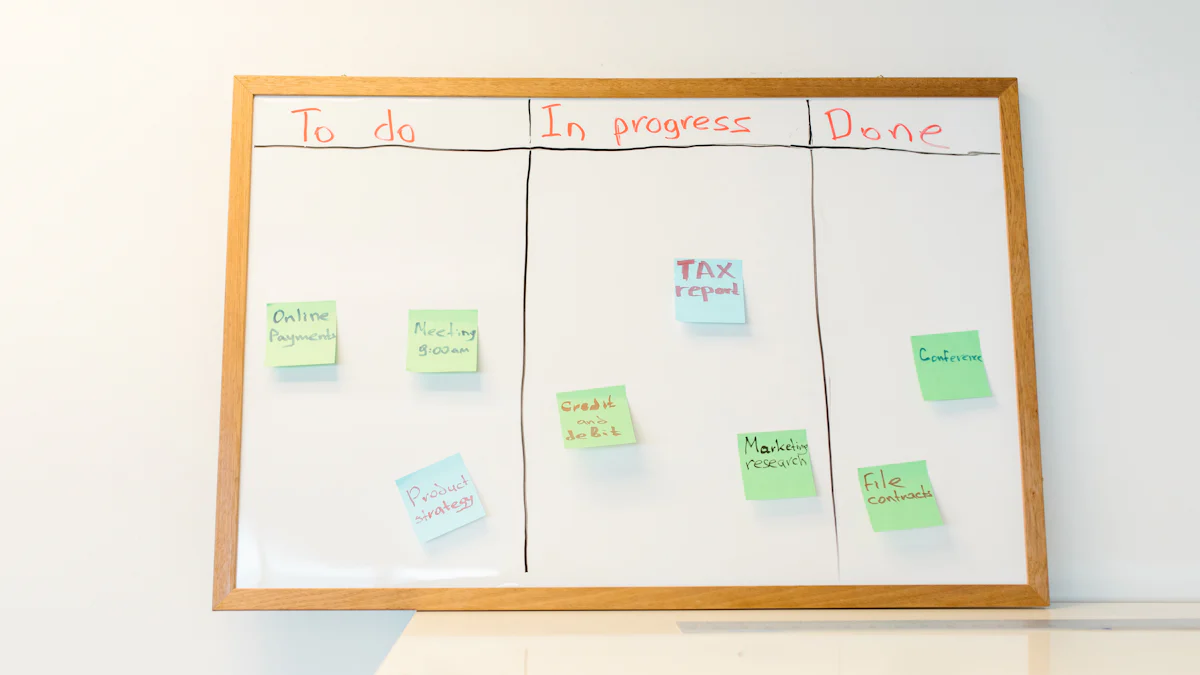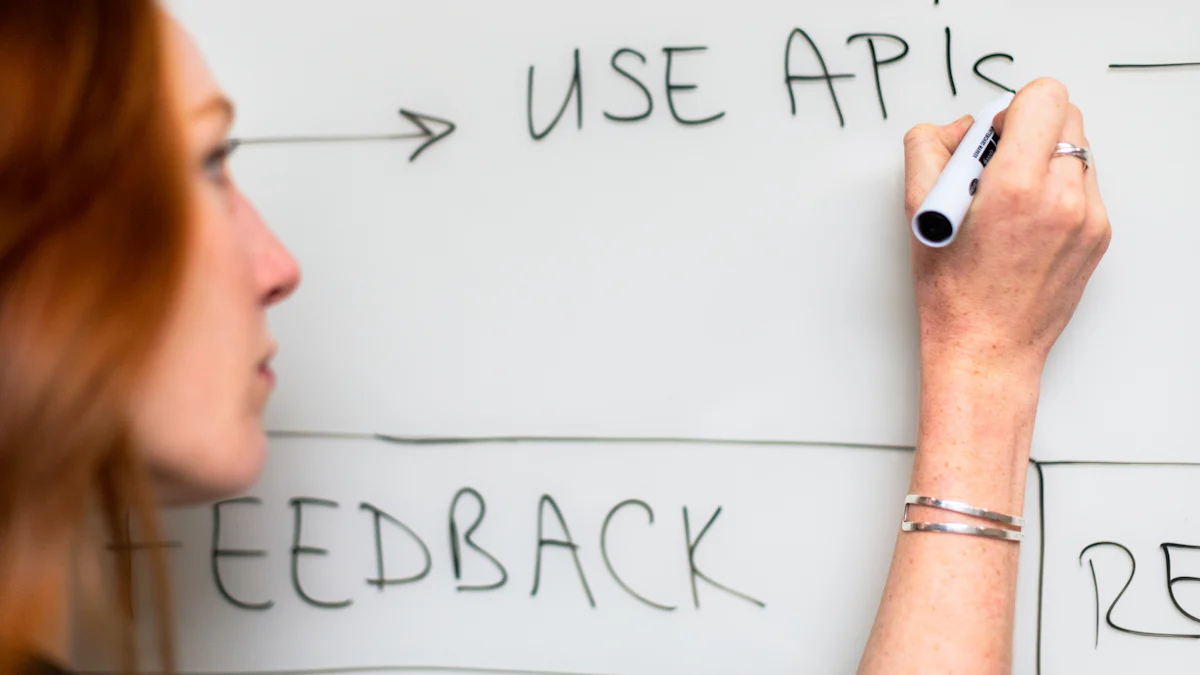What is Lean Product Development Flow

Lean product development flow focuses on delivering customer value by reducing waste, streamlining processes, and enabling rapid iterations. This approach ensures that every step in the software development process contributes directly to creating value for the customer. Its roots lie in lean manufacturing, pioneered by Toyota in the 20th century. Toyota applied lean principles to product design, improving efficiency and fostering innovation. Over time, these ideas evolved into lean product development, which empowers teams to deliver better software faster. By adopting this methodology, you can align your efforts with customer needs while optimizing your product development process.
Key Takeaways
Get rid of waste by removing tasks that don't help customers. Make processes simple to work faster and better.
Make your product good from the beginning. Use tools like auto-testing and checking code to stop mistakes and keep customers happy.
Finish products faster by splitting projects into smaller parts. This helps you get feedback quickly and adjust to changes.
Improve the whole process by making all steps work well together. Don't fix one part if it messes up the rest.
Keep getting better by asking customers for feedback often. Use their ideas to improve your product and meet new needs.
Principles of Lean Product Development Flow

Eliminate Waste
Eliminating waste is one of the core principles of lean product development. Waste refers to any activity that does not add value to the customer. By identifying and removing these inefficiencies, you can streamline your processes and focus on delivering meaningful outcomes. Common examples of waste in traditional development include excess inventory, waiting, defects, and overproduction.
Type of Waste | Description |
|---|---|
Overprocessing | Unnecessary steps in the production line, indicating a poorly designed process. |
Overproduction | Producing more than needed, leading to excess inventory and potential degradation of products. |
Lean principles encourage you to optimize value streams by addressing these inefficiencies. For instance, companies like Toyota have successfully applied lean development to reduce waste and improve efficiency. By focusing on what truly matters, you can create products that resonate with your audience while minimizing unnecessary costs.
Build Quality In
Building quality into your product from the start ensures that you deliver reliable and valuable solutions to your customers. This principle emphasizes proactive measures to prevent defects rather than fixing them later. Lean software development encourages practices like automated testing, code reviews, and continuous integration to maintain high standards.
By embedding quality into every stage of development, you reduce the risk of costly errors and enhance customer satisfaction. Companies like Spotify and Netflix exemplify this approach by using lean development to refine their offerings based on user feedback. When you prioritize quality, you not only save time but also build trust with your audience.
Deliver Fast
Speed is a critical aspect of lean product development. Delivering fast allows you to respond quickly to customer needs and market changes. Lean principles advocate for breaking down large projects into smaller, manageable tasks. This approach enables you to release features incrementally and gather feedback early.
For example, Amazon's data-driven culture and rapid experimentation align with lean development principles. By focusing on delivering value quickly, you can stay ahead of competitors and meet customer expectations. Remember, speed does not mean compromising quality. Instead, it involves optimizing workflows to achieve faster results without sacrificing reliability.
Optimize the Whole
Optimizing the whole means looking at your product development process as a complete system. Instead of focusing on individual parts, you should ensure that every step works together to deliver maximum value to the customer. This principle encourages you to avoid local optimizations that might improve one area but harm the overall flow.
For example, if your team spends too much time perfecting a single feature, it could delay the entire product release. By taking a holistic approach, you can balance priorities and ensure that all efforts contribute to the final outcome. Lean product development emphasizes collaboration across teams to achieve this goal. When everyone aligns their work with the broader objectives, you can eliminate bottlenecks and improve efficiency.
You can also use tools like value stream mapping to identify inefficiencies in your workflow. This technique helps you visualize the entire process and pinpoint areas that need improvement. By optimizing the whole, you create a seamless development process that delivers better results for your customer.
Continuous Improvement
Continuous improvement is a cornerstone of lean product development. This principle focuses on making small, incremental changes to enhance your processes and products over time. Instead of waiting for major overhauls, you should regularly evaluate your work and look for ways to improve.
One way to practice continuous improvement is by gathering feedback from your customer. Their input can help you identify what works and what doesn’t. You can then use this information to refine your product and deliver more value. Lean principles encourage you to embrace experimentation and learn from both successes and failures.
Another key aspect is fostering a culture of learning within your team. Encourage everyone to share ideas and insights that could lead to better outcomes. By prioritizing continuous improvement, you ensure that your development process evolves to meet changing needs and expectations.
How Lean Product Development Flow Works
Ideation and Problem Definition
The first step in lean product development is understanding the problem you aim to solve. This phase begins with thorough market research and direct engagement with potential users. By identifying their pain points, you can uncover opportunities for innovation. For example, if you are developing a project management tool, conducting interviews and surveys can reveal challenges users face, such as difficulty tracking tasks or managing deadlines. These insights help you craft a clear and concise problem statement, which serves as the foundation for the entire development process. A well-defined problem ensures your efforts remain focused on delivering value to your customers.
MVP Creation
Creating a minimum viable product (MVP) is a critical step in lean product development. An MVP allows you to test your ideas with minimal resources while gathering valuable customer feedback. To build an effective MVP, start by validating your assumptions through market research. Define success metrics to measure its performance and prioritize features that address the most pressing user needs. For instance, you might map out the user flow to ensure a seamless experience before launching the MVP. Once released, use the build-measure-learn cycle to refine the product based on real-world data. This iterative process helps you avoid unnecessary investments and focus on what truly matters to your audience.
Iteration and Feedback
Iteration and feedback are at the heart of lean product development. After launching your MVP, you gather customer feedback to identify areas for improvement. This feedback fuels the build-measure-learn cycle, enabling you to test assumptions and refine your product continuously. Companies like Spotify have successfully used this approach to enhance their music streaming features. By listening to users and making incremental changes, they achieved significant growth. Similarly, Toyota integrates feedback from cross-functional teams to improve their processes. Embracing an iterative process ensures your product evolves to meet customer expectations while aligning with lean principles of continuous improvement.
Scaling and Optimization
Scaling and optimization represent the final stages of lean product development. At this point, your focus shifts to refining your product and preparing it for broader adoption. This phase ensures that your solution can handle increased demand while maintaining efficiency and delivering value to your users.
To scale effectively, start by analyzing your product’s performance. Use metrics like user engagement, system reliability, and feature adoption rates to identify areas that need improvement. For example, if a feature struggles under heavy usage, you might need to optimize its code or infrastructure. Scaling isn’t just about adding resources; it’s about ensuring your product remains lean and efficient as it grows.
Optimization involves fine-tuning your processes and workflows. Look for bottlenecks in your development pipeline that slow down delivery. Tools like value stream mapping can help you visualize inefficiencies and prioritize improvements. By streamlining your workflows, you can maintain the speed and agility that define lean principles.
Collaboration plays a key role in this stage. Encourage your team to share insights and propose solutions for scaling challenges. Cross-functional communication ensures that every aspect of your product aligns with user needs and business goals. For instance, developers, designers, and marketers can work together to create a seamless user experience.
Finally, don’t forget to gather feedback from your users. Their input helps you identify what works and what doesn’t as your product scales. Continuous improvement remains essential even at this stage. By iterating based on real-world data, you can ensure your product evolves to meet changing demands while staying true to lean product development principles.
Scaling and optimization are not one-time efforts. They require ongoing attention to ensure your product delivers consistent value as it grows.
Benefits of Lean Product Development Flow

Reduced Waste
Lean product development helps you eliminate waste by focusing only on activities that add value to your customers. This approach minimizes unnecessary steps, materials, and labor hours, making your processes more efficient. For example:
It reduces waste by cutting non-value-adding activities, such as overprocessing or excessive documentation.
It streamlines production by optimizing workflows, ensuring every step contributes to the final product.
It lowers costs and improves ROI by managing resources effectively throughout the development cycle.
By adopting lean principles, you can maximize value while avoiding the pitfalls of traditional development methods. This focus on efficiency ensures your team spends time and resources on what truly matters.
Faster Time to Market
Streamlining your process allows you to release products faster, giving you a competitive edge. Lean product development emphasizes removing unnecessary stages, which simplifies production and shortens delivery timelines.
"Streamlining your process helps you release products faster, giving you a head start on the competition."
With lean practices, you can:
Reduce waste and focus on essential tasks, which accelerates development.
Deliver features incrementally, enabling faster feedback and quicker iterations.
This approach ensures you meet market demands promptly while maintaining high-quality standards. Faster time to market not only satisfies your customers but also positions your product as a leader in its category.
Improved Customer Satisfaction
Lean product development prioritizes customer feedback and collaboration, ensuring your product evolves to meet user needs. Regularly collecting feedback allows you to refine features and address pain points effectively. Key mechanisms that enhance customer satisfaction include:
Mechanism | Description |
|---|---|
Collaborative team approach | Encourages knowledge sharing and cross-functional collaboration, leading to efficient problem-solving. |
No communication silos | Ensures all teams have access to the same information, improving decision-making and problem-solving. |
Streamlined decision-making | Quick decisions without unnecessary bureaucracy, making teams more agile and responsive to needs. |
Customer feedback | Regularly collected feedback ensures products evolve to meet customer expectations. |
By focusing on continuous improvement and user-driven design, you can create products that resonate with your audience. This approach builds trust and loyalty, ensuring long-term success in dynamic markets.
Enhanced Team Collaboration
Lean product development fosters a collaborative environment where teams work together to achieve shared goals. This approach emphasizes breaking down silos and encouraging open communication. When everyone aligns their efforts, your team can deliver better results and create a more efficient workflow.
One key aspect of collaboration in lean product development is cross-functional teamwork. By involving members from different departments, such as design, engineering, and marketing, you ensure that every perspective contributes to the final product. This diversity of ideas leads to innovative solutions and reduces the risk of overlooking critical details.
Tip: Regular stand-up meetings and collaborative tools can help your team stay aligned and address challenges quickly.
Lean principles also promote transparency. Sharing progress, challenges, and feedback openly allows your team to identify bottlenecks and resolve issues faster. For example, using visual management tools like Kanban boards helps everyone track tasks and understand their role in the development process.
Another benefit of lean product development is the focus on shared accountability. When your team takes collective ownership of the product, they feel more invested in its success. This sense of responsibility motivates everyone to contribute their best work.
Finally, lean practices encourage continuous learning. By reflecting on successes and failures, your team can improve collaboration and refine their processes. This culture of improvement strengthens relationships and builds trust among team members.
Enhanced team collaboration not only improves efficiency but also creates a positive work environment. When your team works together effectively, you can deliver high-quality products that meet customer needs.
Role of Feature Flags in Lean Product Development
Reducing Risk
Feature flags play a crucial role in reducing risk during product development. They allow you to release features gradually, starting with a trusted user base. This approach minimizes the chance of widespread issues. By enabling teams to test new features with a subset of users, you can identify and fix bugs before a major release. For instance, if a feature negatively impacts conversions, you can quickly disable it by turning off the flag. This flexibility ensures that your development process remains stable and efficient.
Feature flags also empower engineering teams to deliver more features with less stress. Developers can work more efficiently, knowing they have the ability to control feature rollouts. This reduces the pressure associated with deployments and enhances overall productivity. By using feature flags, you can mitigate risks while maintaining the agility needed for lean product development.
Accelerating Feedback
Feature flags accelerate feedback by enabling controlled feature releases. You can collect targeted feedback from a limited group of users, helping you identify issues early. This approach aligns with lean principles, as it allows for quick iterations based on user responses. For example, developers can fix bugs and refine features before a broader release, ensuring the product meets user expectations.
Audience segmentation further enhances this process. By targeting specific user groups, you can gather precise insights and make informed decisions. This method ensures that features align with user needs before full-scale launches. Feature flags streamline the feedback loop, making it easier to adapt and improve your product in real time.
Minimizing Waste
Feature flags help minimize waste by enabling efficient testing and iteration. Teams can test features without extensive rollbacks or redeployments, saving valuable resources. Gradual feature releases reduce the risk of widespread issues, ensuring that only effective features are deployed. If a feature impacts performance negatively, you can disable it instantly, avoiding unnecessary development cycles.
This approach also allows developers to ship features only when they are ready. Product managers can control release timings and coordinate feedback loops, enhancing overall efficiency. By focusing on what works, feature flags ensure that your development process remains lean and resource-efficient.
Enabling Continuous Improvement
Continuous improvement lies at the heart of lean product development. It ensures your processes and products evolve to meet changing customer needs. Feature flags play a vital role in this journey by enabling you to refine your product based on real-time feedback. You can test new ideas, gather insights, and make adjustments without disrupting the entire system.
For example, you might release a new feature to a small group of users. Their feedback helps you identify what works and what doesn’t. You can then tweak the feature and roll it out to a larger audience. This iterative approach aligns perfectly with lean principles, allowing you to learn and adapt quickly.
Feature flags also support experimentation. You can test multiple variations of a feature simultaneously and determine which one performs best. This data-driven method reduces guesswork and ensures your product delivers maximum value.
Another benefit is the ability to make incremental changes. Instead of waiting for a major update, you can continuously enhance your product in small, manageable steps. This keeps your development process agile and responsive.
By embracing continuous improvement, you foster a culture of learning within your team. Encourage everyone to share ideas and insights that could lead to better outcomes. When you prioritize improvement, you ensure your product remains relevant and competitive in a dynamic market.
Why FeatBit is the Best Feature Flag Tool
FeatBit stands out as the ultimate feature flag tool for lean product development. It empowers you to release features in controlled increments, reducing risk and enhancing agility. With FeatBit, you can toggle features on or off in real time, ensuring stability during development.
The tool accelerates feedback collection by allowing you to target specific user groups. You can gather precise insights and refine your product based on real-world data. This aligns with lean principles of rapid learning and adaptation.
FeatBit also minimizes waste. You can test features without committing extensive resources. If a feature doesn’t perform as expected, you can disable it instantly. This ensures your team focuses only on what adds value.
Moreover, FeatBit enables continuous improvement. Its robust analytics help you track feature performance and identify areas for enhancement. You can make data-driven decisions and optimize your product efficiently.
FeatBit’s user-friendly interface and powerful capabilities make it an essential tool for lean development. It simplifies feature management, supports experimentation, and fosters innovation. By choosing FeatBit, you equip your team with the tools needed to succeed in lean product development.
Tip: Start using FeatBit today to streamline your development process and deliver better products faster.
How to Implement Lean Product Development Flow
Start with a Lean Mindset
Adopting a lean mindset is the foundation of lean product development. You need to focus on creating value for your customers while eliminating waste. Start by forming cross-functional teams that encourage collaboration and knowledge-sharing. These teams help streamline decision-making and improve efficiency. Regularly gather feedback from your customers to ensure your product aligns with their needs.
To implement this mindset effectively, follow these steps:
Identify and focus on your value stream, which includes all activities that contribute to delivering value.
Eliminate waste to create a smooth flow in your processes.
Respond to customer pull by prioritizing their needs.
Pursue perfection through continuous repetition and improvement.
By prioritizing critical features and removing unnecessary ones, you can reduce waste and improve customer satisfaction. This approach ensures your product development efforts remain focused and efficient.
Use Agile Methodologies
Agile methodologies complement lean principles by promoting flexibility and collaboration. Unlike traditional project management, agile focuses on iterative and incremental development. This approach allows you to adapt quickly to changing requirements and deliver value faster.
Characteristics | Traditional approach | |
|---|---|---|
Approach | Iterative and incremental | Linear and sequential |
Feature requirements | Dynamic and changing | Clearly defined upfront |
Customer involvement | High | Low |
Development | Continuous release | One big launch |
Agile methodologies encourage self-organizing teams and frequent communication. Tools like Kanban boards help visualize workflows and track progress. By adopting agile practices, you can enhance team collaboration and ensure your product evolves to meet customer expectations.
Focus on the Customer
A customer-focused approach is essential in lean product development. You should actively engage with your users to understand their needs and pain points. Conduct user interviews, surveys, and testing sessions to gather insights. Create feedback channels where users can share their thoughts consistently.
For example, analyzing data like usage patterns and churn rates can reveal trends that guide your decisions. Establishing a customer advisory board can also provide valuable input for product improvements. By involving your users throughout the development process, you ensure your product delivers meaningful value.
Lean development prioritizes customer-centric value creation. When you focus on your users, you build trust and loyalty, which are key to long-term success.
Measure and Adapt
Measuring and adapting are essential steps in lean product development. These actions ensure your process stays aligned with customer needs and business goals. You must track key metrics to evaluate the success of your product. Metrics like user engagement, feature adoption, and customer satisfaction provide valuable insights. Use these data points to identify areas that need improvement.
Start by defining clear objectives for your product. These objectives guide your measurement efforts. For example, if your goal is to increase user retention, track metrics like daily active users or churn rates. Tools like analytics dashboards help you monitor performance in real time. Regularly review this data to spot trends and patterns.
Adapting involves making changes based on what you learn. If a feature underperforms, refine it or consider removing it. Lean principles encourage you to act quickly. Small, incremental adjustments often lead to significant improvements over time. This approach reduces waste and keeps your development process efficient.
Feedback plays a critical role in adaptation. Gather input from your users through surveys, interviews, or usability tests. Their feedback helps you understand what works and what doesn’t. Use this information to prioritize changes that add the most value.
Collaboration within your team is equally important. Share findings and brainstorm solutions together. Cross-functional teams bring diverse perspectives, which leads to better decisions. By measuring and adapting continuously, you ensure your product evolves to meet customer expectations.
Lean product development thrives on constant learning. When you measure and adapt effectively, you create a cycle of improvement. This cycle keeps your product relevant and competitive in a fast-changing market.
Tip: Use tools like FeatBit to test changes and gather real-time feedback. This ensures your adaptations are data-driven and impactful.
Lean product development focuses on delivering value, reducing waste, and iterating quickly. Its principles, such as eliminating inefficiencies and fostering continuous improvement, apply across industries like healthcare, manufacturing, and software development. Companies like Toyota and Harley-Davidson have achieved remarkable success by adopting lean practices, proving their effectiveness in driving innovation and efficiency.
Feature flags, such as FeatBit, play a vital role in lean and agile development. They allow you to test features in production, gather user feedback, and minimize risks. With tools like FeatBit, you can control feature rollouts, ship only when ready, and adapt quickly to user needs.
Start small by adopting lean principles in your processes. Focus on creating customer value, measure your progress, and refine your approach continuously. By embracing lean product development, you can build better products and achieve long-term success.
FAQ
What is lean product development?
Lean product development is a methodology that focuses on delivering customer value by reducing waste and optimizing processes. It emphasizes rapid iterations and continuous improvement to create efficient workflows and high-quality products.
How does lean differ from traditional development methods?
Lean prioritizes customer value and eliminates unnecessary steps. Traditional methods often follow rigid processes, while lean encourages flexibility, collaboration, and iterative improvements to adapt quickly to changing needs.
Why are feature flags important in lean product development?
Feature flags allow you to test features in real-time with minimal risk. They enable faster feedback, reduce waste, and support continuous improvement by letting you refine features based on user insights.
How can you start implementing lean principles?
Begin by adopting a lean mindset. Focus on customer needs, eliminate waste, and create cross-functional teams. Use tools like feature flags to streamline workflows and measure progress for continuous improvement.
What industries benefit from lean product development?
Lean product development benefits industries like software, manufacturing, and healthcare. Its principles of efficiency, waste reduction, and customer focus apply across various sectors to improve processes and outcomes.
See Also
Top Ten Strategies to Boost Customer Value in Lean Development
Improving Agile Product Development Through Lean Methodologies
Achieving Lean Product Development Mastery for Agile Teams
Enhancing Efficiency and Overcoming Challenges with Lean Agile

